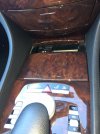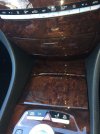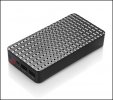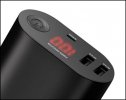It's not like I really needed another power bank but I was intrigued enough by the prospect of a high capacity lithium iron phosphate (LiFePO4) bank to go and buy a TQKA, especially at the modest $22 USD (£15.54) price they are on offer for. I own a few lithium-ion banks, a lithium polymer bank and I figured why not add a lithium iron phosphate to the collection? So now I own Holy Trinity of Power Banks?

Firstly, I'm convinced that the TQKA is indeed a lithium iron phosphate battery bank. The reason is its sheer size and weight. The thing is quite large and significantly heavier than any of the other lithium-ion 20,000 mAh power banks I've had personal experience with and I've owned five of them and handled others. I compared its weight to two li-ion banks with similar capacity ratings, an older generic 20,000mAh lithium-ion and the
Sentey BrioLux LS-2186 20800mAh lithium-ion. The generic weighs in at 14.6 ounces or 414 grams; the Sentey weighs in at 15.6 ounces or 442 grams while the TQKA clocks in at a whopping 1 pound, 9.4 ounces or 720 grams! And while it is similar in length it is much bigger in girth than the others.
One of the hallmarks of lithium iron phosphate (LiFePO4) batteries is that they have far less energy density when compared with the lithium-ion (lithium cobalt oxide - LiCoO2) cells used in typical battery banks. So for this reason, I've concluded that it makes perfect sense that a 20,000 mAh LiFePO4 power bank would weigh so much more than a LiCoO2 power bank of the same capacity and that it would also be larger in size and this seems to confirm that it is what is says is it. I suppose it's also conceivable that the iron component of a lithium iron phosphate battery is contributing to the heavier weight of the cells but that's just mere conjecture.
OK, so when my TQKA power bank first arrived it had a charge of 75%. The first time I used it I was astonished at how quickly the charge depleted. It's my usual practice to simultaneously run two dash cams in my vehicle with power banks and so I preceded to do so with the TQKA on it's initial 75% charge. As I drove, I watched in amazement as the bank dropped from 75% charge down to 43% charge within about twenty minutes! Nevertheless, it turned out there was nothing whatsoever wrong with this power bank as I will explain.
One of the things I've come to learn about lithium based batteries is that they are a bit like muscles in the sense that they need periodic exercise, especially when new or when in storage for long periods of time. The first lithium-ion power bank I purchased four years ago came with a little card in the package that recommended that the bank be run down completely and then fully charged three times before one could expect full performance out of it. I've seen several other references to this phenomenon on several battery related resources on the internet as well. So, I more or less followed this recommendation (for the first two charges) and indeed I noticed that its capacity to hold a charge improved dramatically over the first time I used it. And so, when the TQKA lost so much capacity so quickly after it first arrived at 75% charge I drained it down almost all the way (5%) and then gave it a full charge on a 2 amp charger. There was an immediate and dramatic improvement after doing this and a further improvement after the second full charge. Now it performs quite well and runs many, many hours operating two dash cams simultaneously as one would expect with a bank of this capacity. I suspect that many of the complaints and poor reviews I've seen on Amazon about brand new power banks not holding a charge might have been avoided if the buyers had engaged in breaking in the cells adequately. This is a practice that is otherwise known as "battery cell forming". At this point I expect that the TQKA should provide years of good service and from what I understand about LiFePO4 batteries, should last much longer that a typical LiCoO2 power bank, especially if you engage in good charging practices and avoid stressing the power bank as much as possible in terms of excessive heat, cold, vibration or shock.
Generally speaking, lithium batteries do not like being fully depleted and you will get much longer life out of them if you keep them topped off and avoid deep discharges. Deeply discharging of lithium batteries is OK periodically but should generally be avoided. So, the above recommendation to drain the bank fully should only be undertaken when the battery bank is new. Then again, I'm still learning about LiFePO4 batteries and for now I don't know for sure if they tolerate deep discharges better or worse than LiCoO2 cells, so for now at least I'm continuing to follow the practices I use with li-ion cells until I have clarification on this. I do know that lithium batteries are rated for number of charge/discharge cycles and keeping them topped off avoids a full "cycle" so to speak.
TQKA power bank has what I consider to be two major design flaws, one quite serious and one merely annoying.
As I mentioned, I've owned five other power banks going back four years now and I've had the opportunity to handle and examine several others. In each and every case, all these power banks have ON/OFF switches that are flush with the surface of the bank's housing or slightly recessed. In each case, it is quite clear that these banks are designed so that they are difficult to turn on accidentally. They all require an intentional decision to switch them on or off as they require a distinct amount of pressure on the switch and in some cases the switch must be pressed for a second or two to activate the bank. The TQKA, on the other hand, is the ONLY power bank I've encountered with a protruding power button and only the
slightest momentary pressure on the button switches on the current. I consider this to be a significant safety issue! This is a powerful, energy dense device that could easily be switched on with the slightest bump up against something, especially inside a moving vehicle. The notion that this battery could switch on devices accidentally or more importantly could cause a short circuit if something were to come into contact with the ports is a serious issue that even made me consider returning it. I knew before I purchased it that it had a protruding on/off button but I never imagined that it would be designed with such a hair trigger. Not good.

The other design flaw, the one I find annoying is the LED numerical display. Every other power bank I've owned or tested has indicator lights or an illuminated charge status display that turns off after a few seconds. For one thing, this conserves power. For me, the issue is stealth. I usually keep my power banks in a "cubby hole" that is part of my center console and just under the dash. The power banks are discrete and hard to notice and I like it that way. With the large red numerals on the TQKA glowing constantly in the dark, it draws attention, especially if I park somewhere at night and I question the wisdom of such a design. The large LED display is also an unnecessary parasitic load on the battery. Again, I considered returning this power bank for a refund because of this but decided to keep it and find a work around for the sake of testing out a LiFePO4 power bank.
So, I think this is an interesting product and as someone who likes to run dash cam with power banks, even on hot summer days, I think this will be a useful device but I do wish the engineers had thought through some of these issues a bit better.







